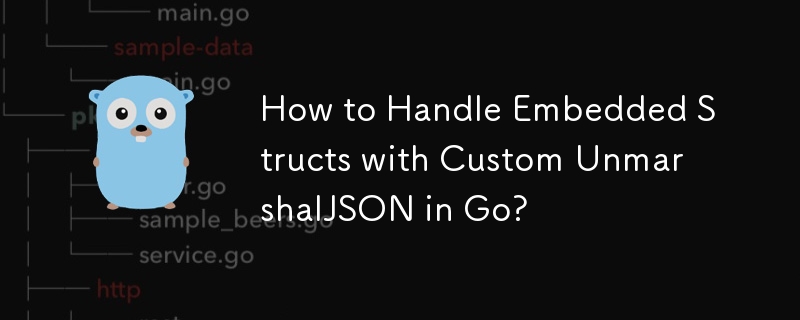如何在 Go 中使用自定义 UnmarshalJSON 处理嵌入式结构?
发布于2024-11-09

错误处理:嵌入式结构的自定义解组
在 Go 中,当将 JSON 数据解组到具有嵌入式字段的结构时,如果嵌入式结构定义了其自己的 UnmarshalJSON 方法。这是因为 JSON 库调用嵌入结构的 UnmarshalJSON 并忽略包含结构中定义的字段。
案例研究
考虑以下结构定义:
type Outer struct {
Inner
Num int
}
type Inner struct {
Data string
}
func (i *Inner) UnmarshalJSON(data []byte) error {
i.Data = string(data)
return nil
}当使用 json.Unmarshal(data, &Outer{}) 将 JSON 解组到 Outer 时,Inner 字段会触发其 UnmarshalJSON 方法,消耗整个 JSON 字符串。这会导致 Outer 中的 Num 字段被忽略。
解决方案:显式字段
要解决此问题,请将嵌入的 struct Inner 转换为 Outer 中的显式字段:
type Outer struct {
I Inner // make Inner an explicit field
Num int `json:"Num"`
}通过将 Inner 设为显式字段,您可以确保 JSON 库将数据解组到 Outer 的相应字段中,包括 Num 字段。
示例
import (
"encoding/json"
"fmt"
)
type Outer struct {
I Inner // make Inner an explicit field
Num int `json:"Num"`
}
type Inner struct {
Data string
}
func (i *Inner) UnmarshalJSON(data []byte) error {
i.Data = string(data)
return nil
}
func main() {
data := []byte(`{"Data": "Example", "Num": 42}`)
var outer Outer
err := json.Unmarshal(data, &outer)
if err != nil {
fmt.Println(err)
}
fmt.Println(outer.I.Data, outer.Num) // Output: Example 42
}
最新教程
更多>
-
 如何将日期转换为数字格式以进行绘图?将日期转换为数字格式以进行绘图当日期以不同格式存储时,根据日期绘制数据可能具有挑战性,例如“1991 年 1 月 2 日。”本文提供了一种将日期转换为可以轻松在 x 轴上绘制的数字格式的解决方案。如问题中所述,使用 strftime('%Y%m%d') 转换日期仅靠这一点可能还不够。...编程 发布于2024-11-09
如何将日期转换为数字格式以进行绘图?将日期转换为数字格式以进行绘图当日期以不同格式存储时,根据日期绘制数据可能具有挑战性,例如“1991 年 1 月 2 日。”本文提供了一种将日期转换为可以轻松在 x 轴上绘制的数字格式的解决方案。如问题中所述,使用 strftime('%Y%m%d') 转换日期仅靠这一点可能还不够。...编程 发布于2024-11-09 -
 如何修复 macOS 上 Django 中的“配置不正确:加载 MySQLdb 模块时出错”?MySQL配置不正确:相对路径的问题在Django中运行python manage.py runserver时,可能会遇到以下错误:ImproperlyConfigured: Error loading MySQLdb module: dlopen(/Library/Python/2.7/site-...编程 发布于2024-11-09
如何修复 macOS 上 Django 中的“配置不正确:加载 MySQLdb 模块时出错”?MySQL配置不正确:相对路径的问题在Django中运行python manage.py runserver时,可能会遇到以下错误:ImproperlyConfigured: Error loading MySQLdb module: dlopen(/Library/Python/2.7/site-...编程 发布于2024-11-09 -
 如何使用 JavaScript 在 Android 浏览器中可靠地检测设备旋转?使用 JavaScript 检测 Android 浏览器中的设备旋转检测旋转的兼容性挑战使用 JavaScript 检测设备旋转与具有明确定义方法的 iPhone 相比,Android 手机上的浏览器可能更具挑战性。 Android 设备上的行为可能不一致,事件的顺序和频率以及 screen.wid...编程 发布于2024-11-09
如何使用 JavaScript 在 Android 浏览器中可靠地检测设备旋转?使用 JavaScript 检测 Android 浏览器中的设备旋转检测旋转的兼容性挑战使用 JavaScript 检测设备旋转与具有明确定义方法的 iPhone 相比,Android 手机上的浏览器可能更具挑战性。 Android 设备上的行为可能不一致,事件的顺序和频率以及 screen.wid...编程 发布于2024-11-09 -
 Bootstrap 4 Beta 中的列偏移发生了什么?Bootstrap 4 Beta:列偏移的删除和恢复Bootstrap 4 在其 Beta 1 版本中引入了重大更改柱子偏移了。然而,随着 Beta 2 的后续发布,这些变化已经逆转。从 offset-md-* 到 ml-auto在 Bootstrap 4 Beta 1 中, offset-md-*...编程 发布于2024-11-09
Bootstrap 4 Beta 中的列偏移发生了什么?Bootstrap 4 Beta:列偏移的删除和恢复Bootstrap 4 在其 Beta 1 版本中引入了重大更改柱子偏移了。然而,随着 Beta 2 的后续发布,这些变化已经逆转。从 offset-md-* 到 ml-auto在 Bootstrap 4 Beta 1 中, offset-md-*...编程 发布于2024-11-09 -
 在 JavaScript 中缓存数组长度比直接长度访问更快吗?优化 JavaScript 中的数组迭代:缓存长度与直接长度访问循环数组是 JavaScript 中的基本操作。但最快的方法是什么?传统观点认为,缓存数组的长度可以通过避免重复计算来提高性能。然而,一些人认为现代编译器优化了直接长度访问。争论:缓存与直接访问传统上,推荐的方法是缓存数组长度: for...编程 发布于2024-11-09
在 JavaScript 中缓存数组长度比直接长度访问更快吗?优化 JavaScript 中的数组迭代:缓存长度与直接长度访问循环数组是 JavaScript 中的基本操作。但最快的方法是什么?传统观点认为,缓存数组的长度可以通过避免重复计算来提高性能。然而,一些人认为现代编译器优化了直接长度访问。争论:缓存与直接访问传统上,推荐的方法是缓存数组长度: for...编程 发布于2024-11-09 -
 除了“if”语句之外:还有哪些地方可以在不进行强制转换的情况下使用具有显式“bool”转换的类型?无需强制转换即可上下文转换为 bool您的类定义了对 bool 的显式转换,使您能够在条件语句中直接使用其实例“t”。然而,这种显式转换提出了一个问题:“t”在哪里可以在不进行强制转换的情况下用作 bool?上下文转换场景C 标准指定了四种值可以根据上下文转换为的主要场景bool:语句:if、whi...编程 发布于2024-11-09
除了“if”语句之外:还有哪些地方可以在不进行强制转换的情况下使用具有显式“bool”转换的类型?无需强制转换即可上下文转换为 bool您的类定义了对 bool 的显式转换,使您能够在条件语句中直接使用其实例“t”。然而,这种显式转换提出了一个问题:“t”在哪里可以在不进行强制转换的情况下用作 bool?上下文转换场景C 标准指定了四种值可以根据上下文转换为的主要场景bool:语句:if、whi...编程 发布于2024-11-09 -
 如何使用纯 JavaScript 切换元素类?使用纯 JavaScript 切换元素类:综合指南简介在 JavaScript 中,控制元素类对于动态 Web 开发至关重要。一项常见任务是切换类以更改元素的外观或功能。虽然 jQuery 使这项任务变得简单,但了解如何使用纯 JavaScript 来完成它是至关重要的。jQuery 解决方案和 J...编程 发布于2024-11-09
如何使用纯 JavaScript 切换元素类?使用纯 JavaScript 切换元素类:综合指南简介在 JavaScript 中,控制元素类对于动态 Web 开发至关重要。一项常见任务是切换类以更改元素的外观或功能。虽然 jQuery 使这项任务变得简单,但了解如何使用纯 JavaScript 来完成它是至关重要的。jQuery 解决方案和 J...编程 发布于2024-11-09 -
 如何使用 Base64 对 OpenSearch 插件的图像进行编码?为 OpenSearch 插件编码图像为 Firefox 或 IE 等浏览器开发 OpenSearch 插件时,base64 编码对于表示图像至关重要。具体实现方法如下:方法一:在线编码访问在线文件编码网站,例如[Base64 Encode](https:// /www.base64encode.o...编程 发布于2024-11-09
如何使用 Base64 对 OpenSearch 插件的图像进行编码?为 OpenSearch 插件编码图像为 Firefox 或 IE 等浏览器开发 OpenSearch 插件时,base64 编码对于表示图像至关重要。具体实现方法如下:方法一:在线编码访问在线文件编码网站,例如[Base64 Encode](https:// /www.base64encode.o...编程 发布于2024-11-09 -
 使用 Java 的 JarOutputStream 创建 JAR 文件时如何避免意外问题?对 JAR 文件创建的 JarOutputStream 进行故障排除使用 java.util.jar.JarOutputStream 以编程方式创建 JAR 文件看起来很简单,但某些细微差别可能会导致意外问题。本文探讨了这些未记录的怪癖,并提供了用于创建有效 JAR 文件的全面解决方案。了解怪癖使用...编程 发布于2024-11-09
使用 Java 的 JarOutputStream 创建 JAR 文件时如何避免意外问题?对 JAR 文件创建的 JarOutputStream 进行故障排除使用 java.util.jar.JarOutputStream 以编程方式创建 JAR 文件看起来很简单,但某些细微差别可能会导致意外问题。本文探讨了这些未记录的怪癖,并提供了用于创建有效 JAR 文件的全面解决方案。了解怪癖使用...编程 发布于2024-11-09 -
 如何在不中断内容流的情况下将 Div 绝对放置在右侧:解决 Float:right 与 Position:absolute 的困境右浮动和绝对定位困境已解决在您追求一个 div 能够无缝地将其自身与其父级右侧对齐,同时避免干扰其他内容,您偶然发现了一个障碍: float:right 和 float:right 的冲突行为position:absolute.Float 和 Absolute 的冲突性质Float:right 通过...编程 发布于2024-11-09
如何在不中断内容流的情况下将 Div 绝对放置在右侧:解决 Float:right 与 Position:absolute 的困境右浮动和绝对定位困境已解决在您追求一个 div 能够无缝地将其自身与其父级右侧对齐,同时避免干扰其他内容,您偶然发现了一个障碍: float:right 和 float:right 的冲突行为position:absolute.Float 和 Absolute 的冲突性质Float:right 通过...编程 发布于2024-11-09 -
 如何在不修改 http.ResponseWriter 的情况下记录 HTTP 响应?在 http.HandleFunc 中记录 HTTP 响应本文讨论了一种获取 HTTP 响应以进行日志记录的替代方法,而无需诉诸伪造请求或修改 http.ResponseWriter。我们引入了中间件链接的概念,提供了函数式实现。中间件链接中间件链接涉及将控制权传递给处理程序链,这些处理程序在主请求...编程 发布于2024-11-09
如何在不修改 http.ResponseWriter 的情况下记录 HTTP 响应?在 http.HandleFunc 中记录 HTTP 响应本文讨论了一种获取 HTTP 响应以进行日志记录的替代方法,而无需诉诸伪造请求或修改 http.ResponseWriter。我们引入了中间件链接的概念,提供了函数式实现。中间件链接中间件链接涉及将控制权传递给处理程序链,这些处理程序在主请求...编程 发布于2024-11-09 -
 如何在 PHP 中有效使用回调?在 PHP 中实现回调PHP 中的术语“回调”包括作为函数指针操作的字符串和数组。在 PHP 4 中,出现了以下语法:$cb1 = 'someGlobalFunction';$cb2 = ['ClassName', 'someStaticMethod'...编程 发布于2024-11-09
如何在 PHP 中有效使用回调?在 PHP 中实现回调PHP 中的术语“回调”包括作为函数指针操作的字符串和数组。在 PHP 4 中,出现了以下语法:$cb1 = 'someGlobalFunction';$cb2 = ['ClassName', 'someStaticMethod'...编程 发布于2024-11-09 -
 如何检查 Chrome 和 Firefox 中的元素?您有没有想过一个制作精美的网站背后有哪些元素?了解如何检查 Chrome 和 Firefox 中的元素。 每个视觉上令人惊叹的网页都有复杂的 HTML、CSS 和 JavaScript 代码在后端运行。使用名为 Inspect Element 的便捷开发工具,您可以在流行的网络浏览器上检查 HTM...编程 发布于2024-11-09
如何检查 Chrome 和 Firefox 中的元素?您有没有想过一个制作精美的网站背后有哪些元素?了解如何检查 Chrome 和 Firefox 中的元素。 每个视觉上令人惊叹的网页都有复杂的 HTML、CSS 和 JavaScript 代码在后端运行。使用名为 Inspect Element 的便捷开发工具,您可以在流行的网络浏览器上检查 HTM...编程 发布于2024-11-09 -
 为什么在 C++ 中设置静态字段时出现“无法解析的外部符号”错误?静态对象字段的无法解析的外部符号本文调查了尝试设置时遇到的错误消息“error LNK2001:无法解析的外部符号”主方法中的类中的静态字段。在提供的代码片段中,类中静态字段“a”的声明“B”出现在类定义本身内。但是,根据 C 标准,此类声明不被视为定义。对于静态数据成员,正确的定义必须出现在封闭命...编程 发布于2024-11-09
为什么在 C++ 中设置静态字段时出现“无法解析的外部符号”错误?静态对象字段的无法解析的外部符号本文调查了尝试设置时遇到的错误消息“error LNK2001:无法解析的外部符号”主方法中的类中的静态字段。在提供的代码片段中,类中静态字段“a”的声明“B”出现在类定义本身内。但是,根据 C 标准,此类声明不被视为定义。对于静态数据成员,正确的定义必须出现在封闭命...编程 发布于2024-11-09 -
 如何在 PHP 中高效去除小数中的尾随零?在 PHP 中删除小数中的尾随零在 PHP 中,从小数中删除尾随零是一项常见任务。考虑以下场景:您有一组数字,如 125.00、966.70 和 844.011,您希望显示这些数字,但不包含不必要的零数字。快速且优化的解决方案为了有效地完成此任务,您可以采用简单而有效的解决方案,将数字添加到 0。此...编程 发布于2024-11-09
如何在 PHP 中高效去除小数中的尾随零?在 PHP 中删除小数中的尾随零在 PHP 中,从小数中删除尾随零是一项常见任务。考虑以下场景:您有一组数字,如 125.00、966.70 和 844.011,您希望显示这些数字,但不包含不必要的零数字。快速且优化的解决方案为了有效地完成此任务,您可以采用简单而有效的解决方案,将数字添加到 0。此...编程 发布于2024-11-09
学习中文
- 1 走路用中文怎么说?走路中文发音,走路中文学习
- 2 坐飞机用中文怎么说?坐飞机中文发音,坐飞机中文学习
- 3 坐火车用中文怎么说?坐火车中文发音,坐火车中文学习
- 4 坐车用中文怎么说?坐车中文发音,坐车中文学习
- 5 开车用中文怎么说?开车中文发音,开车中文学习
- 6 游泳用中文怎么说?游泳中文发音,游泳中文学习
- 7 骑自行车用中文怎么说?骑自行车中文发音,骑自行车中文学习
- 8 你好用中文怎么说?你好中文发音,你好中文学习
- 9 谢谢用中文怎么说?谢谢中文发音,谢谢中文学习
- 10 How to say goodbye in Chinese? 再见Chinese pronunciation, 再见Chinese learning

























